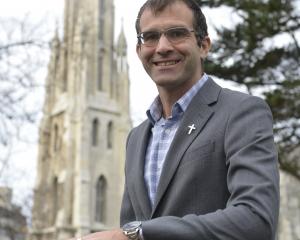In a secular world, Luke's account of Pentecost - just past - is enlivened by linking it with the Jewish scriptures and, in particular with their coded meanings of wind and fire, suggests Ian Harris.
There seems to be an abiding fascination with far-fetched stories of arcane practices, codes and symbols reverberating in modern times.
How else do you explain the phenomenal appeal of Dan Brown's Angels and Demons and The Da Vinci Code, drawing on secretive societies from the past and running amok in present-day conspiracies and fantasies?Contrasting starkly with Brown's money-spinning romps is an even older story where codes and symbols are used to much better effect.
It is the New Testament account of Pentecost, which churches around the world celebrated on May 31.
This is not a story to be interpreted literally - though many Christians will do just that, missing the codes and so missing the point.
Unlock the symbolic links, however, and the story is transformed.
Pentecost began way back as a harvest festival in Palestine.
Later its focus switched to the Old Testament story of Moses receiving the Ten Commandments and Jewish sacred law on Mt Sinai.
The festival was celebrated on the 50th day after Passover ("pentecost" means fiftieth), which commemorates that other pivotal event in Jewish history when the Israelites broke free from slavery in Egypt, about 1300 BC.
Jesus' early followers took up the festival and gave it a totally new meaning.
This, they said, was the day when the Holy Spirit promised by Jesus came upon them, 50 days after the traumatic events of the first Easter.
As Luke tells it, a motley company of Jesus' followers, hailing from around the known world, had gathered for the Jewish Pentecost in a house in Jerusalem.
Suddenly a violent gust of wind rushed through the house, a tongue of flame hovered over every head, and everyone could understand what others were saying, whatever their native tongue.
To which the sceptical Kiwi will say: "Yeah, right!"
To bring the story alive in our secular world you need to burrow deeper, for Luke has deftly woven into his account a number of threads which link the story with the Jewish scriptures, and which hold the key to its meaning.
In Luke's day those links would have been obvious to Jesus' Jewish followers. They are not self-evident today.
For Jews, wind was associated with the breath of life and with spirit.
Their story of creation is a prime example: it was the spirit or wind of God moving upon a watery chaos that brought the world into being.
In the prophet Ezekiel's allegory of the valley of dry bones, the bones revived when the four winds blew life back into them.
Fire is another recurring symbol of divine presence. Moses sensed this in his experience of a bush that seemed to be ablaze, yet was not burnt up. There was also fire and smoke on Mt Sinai when he received the Ten Commandments.
Was that a volcano erupting? Wind and fire come together in the story of the prophet Elijah being carried bodily up into heaven, then thought of as a real place lying just beyond the solid canopy that separated Earth and its atmosphere from the heavenly world above.
A whirlwind is said to have whisked Elijah aloft in a chariot of fire.
English rugby crowds draw on that imagery whenever they sing "Swing low, sweet chariot".
And so does Luke when he describes a sound like a violent wind enveloping that gathering in Jerusalem, and tongues of fire resting on everyone present.
This is not an eye-witness observation.
It is a creative way of imaginatively linking a profound present experience to key events and symbols in the Jews' religious past, while also claiming that this event went way beyond them.
As for the unscrambling of the languages, that is the flipside of the mythical Old Testament story of the Tower of Babel.
There, people's hubris over-reached itself when they set out to build a tower so high that it would stretch into heaven. But God thwarted them. He jumbled their languages so they couldn't pull it off.
This confusion of languages came to represent the divisions of humanity, and to symbolise its brokenness.
Luke's coded story of Pentecost reverses that. The experience broke down barriers between people. Wind and fire symbolised the presence of the Holy Spirit. People of many tribes and nations found themselves at one with each other.
They felt liberated and empowered - a feeling so ecstatic that onlookers thought they were all drunk.
It was the beginning of the church's expansion from a movement within Judaism to a worldwide faith. Sure beats Dan Brown.
- Ian Harris is a journalist and commentator












